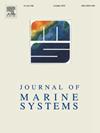The Coffin Bay Estuary: Influences from coastal upwelling in the eastern Great Australian Bight
IF 2.5
3区 地球科学
Q2 GEOSCIENCES, MULTIDISCIPLINARY
引用次数: 0
Abstract
Using a coupled physical-biological model at different grid resolutions, this work explores the influences from coastal upwelling on the Coffin Bay Estuary in the eastern Great Australian Bight. The Coffin Bay Estuary, which is a negative estuary, consists of a series of interconnected smaller bay. The findings show the main upwelling plume is topographically steered around but does not enter the Coffin Bay Estuary. Instead, the nitrogen load in seawaters near the estuary is derived from secondary circulations and horizontal turbulence. However, due to photosynthetic consumption in the main upwelling zone, dissolved nitrogen levels are reduced to low values (∼0.8 μM) near the estuary and can only support slow phytoplankton growth. While wind-driven currents rapidly flush the outer bay of the estuary, called Coffin Bay, on a timescale of 5 days, this excludes shallower (<20 m) nearshore water that has a turnover time > 40 days. However, it is this shallower water that is connected to the first inner bay of the estuary, Port Douglas Bay, via strong (>1 m/s) tidal flows in the narrow channel. The other inner bays of the estuary have flushing times >100 days and are not influenced by processes on the ambient continental shelf. Hence, the coastal upwelling region in the eastern Great Australian Bight has generally no or only little influence on the nutrient budget in the Coffin Bay Estuary.
科芬湾河口:大澳大利亚湾东部沿海上升流的影响
利用不同网格分辨率的耦合物理-生物模型,本研究探讨了沿海上升流对大澳大利亚湾东部科芬湾河口的影响。科芬湾河口是一个负河口,由一系列相互连接的小海湾组成。研究结果表明,主要的上升流柱在地形上被引导,但没有进入科芬湾河口。相反,河口附近海水的氮负荷来源于二次环流和水平湍流。然而,由于主要上升流区的光合作用消耗,溶解氮水平在河口附近降至低值(~ 0.8 μM),只能支持浮游植物的缓慢生长。虽然风驱动的洋流以5天的时间尺度迅速冲刷河口外湾,称为科芬湾,但这不包括较浅(20米)的近岸水域,因为它有一个周转时间。40天。然而,正是这片较浅的水域,通过狭窄水道中强烈的(1m /s)潮汐流,与河口的第一个内湾道格拉斯港湾相连。河口的其他内湾的冲刷时间为100天,不受周围大陆架过程的影响。因此,大澳大利亚湾东部沿海上升流区对科芬湾河口的营养收支一般没有或只有很小的影响。
本文章由计算机程序翻译,如有差异,请以英文原文为准。
求助全文
约1分钟内获得全文
求助全文
来源期刊

Journal of Marine Systems
地学-地球科学综合
CiteScore
6.20
自引率
3.60%
发文量
81
审稿时长
6 months
期刊介绍:
The Journal of Marine Systems provides a medium for interdisciplinary exchange between physical, chemical and biological oceanographers and marine geologists. The journal welcomes original research papers and review articles. Preference will be given to interdisciplinary approaches to marine systems.
 求助内容:
求助内容: 应助结果提醒方式:
应助结果提醒方式:


